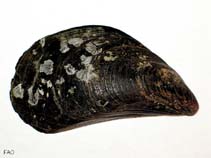Mytilus galloprovincialis Lamarck, 1819
Mediterranean mussel| Native range | All suitable habitat | Point map | Year 2050 |

|
| This map was computer-generated and has not yet been reviewed. |
| Mytilus galloprovincialis AquaMaps Data sources: GBIF OBIS |
Classification / Names Common names | Synonyms | CoL | ITIS | WoRMS
Bivalvia | Mytilida | Mytilidae
Environment: milieu / climate zone / depth range / distribution range Ecology
Benthic; depth range 125 - 200 m (Ref. 2754). Tropical, preferred 16°C (Ref. 107945); 61°N - 30°N, 11°W - 36°E
Distribution Countries | FAO areas | Ecosystems | Occurrences | Introductions
Northeast Atlantic, the Mediterranean and the Black Sea. Introduced to the Arctic, Indian and Pacific Oceans.
Length at first maturity / Size / Weight / Age
Maturity: Lm ? range ? - ? cm Max length : 16.5 cm SHL male/unsexed; (Ref. 109255)
Short description Morphology
Life cycle and mating behavior Maturity | Reproduction | Spawning | Eggs | Fecundity | Larvae
Main reference
References | Coordinator | Collaborators
Demir, M. 2003 Shells of mollusca collected from the seas of Turkey. Turkey Journal of Zoology 27:101-140. (Ref. 2754)
IUCN Red List Status
(Ref. 130435: Version 2025-1)
CITES status (Ref. 108899)
CMS (Ref. 116361)
Threat to humans
Human uses
Fisheries: commercial
FAO - Aquaculture: production, species profile; Fisheries: landings, species profile | FishSource | Sea Around Us
Tools
More information
Internet sources
BHL | BOLD Systems | CISTI | DiscoverLife | FAO(Aquaculture: species profile; Fisheries: species profile; publication : search) | Fishipedia | GenBank (genome, nucleotide) | GloBI | Gomexsi | Google Books | Google Scholar | Google | PubMed | Tree of Life | Wikipedia (Go, Search) | Zoological Record



